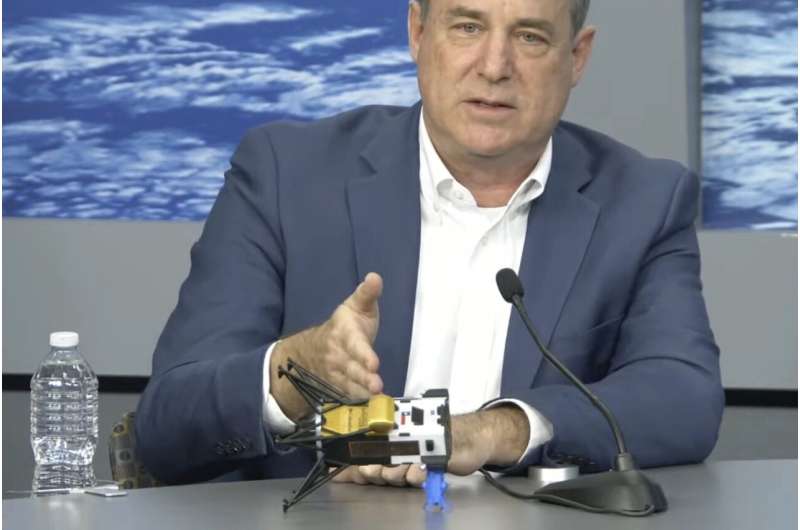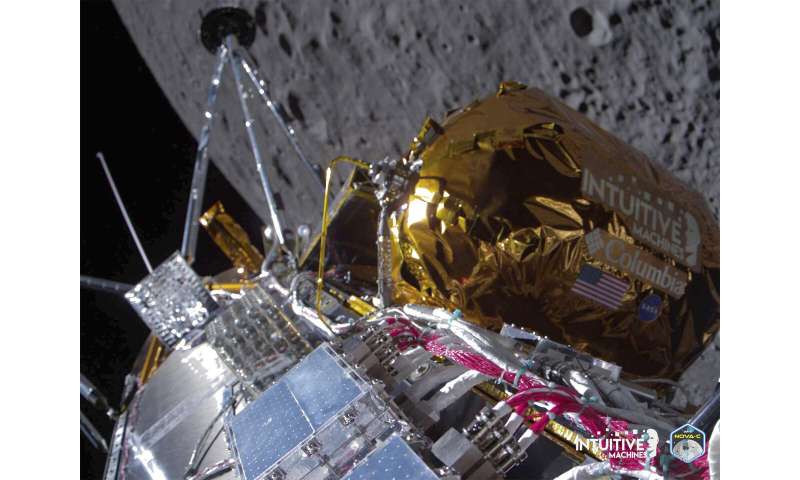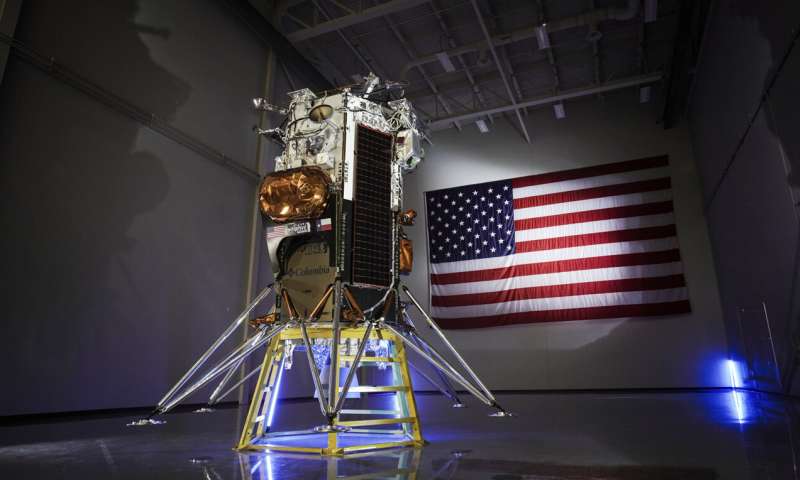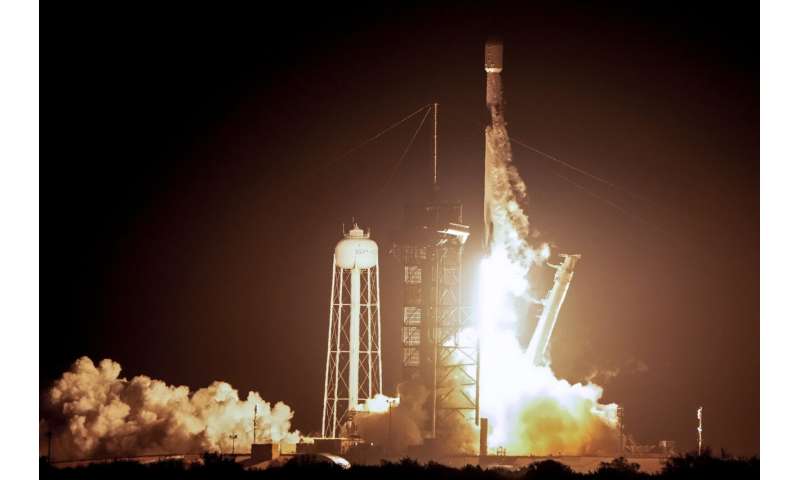A private U.S. lunar lander tipped over at touchdown and ended up on its side near the moon’s south pole, hampering communications, company officials said Friday.
Intuitive Machines initially believed its six-footed lander, Odysseus, was upright after Thursday’s touchdown. But CEO Steve Altemus said Friday the craft “caught a foot in the surface,” falling onto its side and, quite possibly, leaning against a rock. He said it was coming in too fast and may have snapped a leg.
“So far, we have quite a bit of operational capability even though we’re tipped over,” he told reporters.
But some antennas were pointed toward the surface, limiting flight controllers’ ability to get data down, Altemus said. The antennas were stationed high on the 14-foot (4.3-meter) lander to facilitate communications at the hilly, cratered and shadowed south polar region.
Odysseus—the first U.S. lander in more than 50 years—is thought to be within a few miles (kilometers) of its intended landing site near the Malapert A crater, less than 200 miles (300 kilometers) from the south pole. NASA, the main customer, wanted to get as close as possible to the pole to scout out the area before astronauts show up later this decade.

NASA’s Lunar Reconnaissance Orbiter will attempt to pinpoint the lander’s location, as it flies overhead this weekend.
With Thursday’s touchdown, Intuitive Machines became the first private business to pull off a moon landing, a feat previously achieved by only five countries. Japan was the latest country to score a landing, but its lander also ended up on its side last month.
Odysseus’ mission was sponsored in large part by NASA, whose experiments were on board. NASA paid $118 million for the delivery under a program meant to jump-start the lunar economy.
One of the NASA experiments was pressed into service when the lander’s navigation system did not kick in. Intuitive Machines caught the problem in advance when it tried to use its lasers to improve the lander’s orbit. Otherwise, flight controllers would not have discovered the failure until it was too late, just five minutes before touchdown.

“Serendipity is absolutely the right word,” mission director Tim Crain said.
It turns out that a switch was not flipped before flight, preventing the system’s activation in space.
Launched last week from Florida, Odysseus took an extra lap around the moon Thursday to allow time for the last-minute switch to NASA’s laser system, which saved the day, officials noted.
Another experiment, a cube with four cameras, was supposed to pop off 30 seconds before touchdown to capture pictures of Odysseus’ landing. But Embry-Riddle Aeronautical University’s EagleCam was deliberately powered off during the final descent because of the navigation switch and stayed attached to the lander.
Embry-Riddle’s Troy Henderson said his team will try to release EagleCam in the coming days, so it can photograph the lander from roughly 26 feet (8 meters) away.
-

This image provided by Intuitive Machines shows its Odysseus lunar lander over the near side of the moon following lunar orbit insertion, Wednesday, Feb. 21, 2024. Intuitive Machines reported Friday, Feb. 23, 2024, that it’s communicating with its lander, Odysseus, and sending commands to acquire science data. But it noted: “We continue to learn more about the vehicle’s specific information” regarding location, overall health and positioning. Credit: Intuitive Machines via AP, File
-

This photo provided by Intuitive Machines shows the company’s IM-1 Nova-C lunar lander in Houston in October 2023. Intuitive Machines reported Friday, Feb. 23, 2024, that it’s communicating with its lander, Odysseus, and sending commands to acquire science data. But it noted: “We continue to learn more about the vehicle’s specific information” regarding location, overall health and positioning. Credit: Intuitive Machines via AP, File
-

A SpaceX Falcon 9 rocket, carrying Intuitive Machines’ lunar lander, lifts off from pad 39A at Kennedy Space Center in Cape Canaveral, Fla., early Thursday, Feb. 15, 2024. Intuitive Machines reported Friday, Feb. 23, 2024, that it’s communicating with its lander, Odysseus, and sending commands to acquire science data. But it noted: “We continue to learn more about the vehicle’s specific information” regarding location, overall health and positioning. Credit: AP Photo/John Raoux, File
“Getting that final picture of the lander on the surface is still an incredibly important task for us,” Henderson told The Associated Press.
Intuitive Machines anticipates just another week of operations on the moon for the solar-powered lander—nine or 10 days at most—before lunar nightfall hits.
The company was the second business to aim for the moon under NASA’s commercial lunar services program. Last month, Pittsburgh’s Astrobotic Technology gave it a shot, but a fuel leak on the lander cut the mission short and the craft ended up crashing back to Earth.
Until Thursday, the U.S. had not landed on the moon since Apollo 17’s Gene Cernan and Harrison Schmitt closed out NASA’s famed moon-landing program in December 1972. NASA’s new effort to return astronauts to the moon is named Artemis after Apollo’s mythological twin sister. The first Artemis crew landing is planned for 2026 at the earliest.
© 2024 The Associated Press. All rights reserved. This material may not be published, broadcast, rewritten or redistributed without permission.
Citation:
Private US spacecraft is on its side on the moon with some antennas covered up, the company says (2024, February 24)
retrieved 24 February 2024
from https://phys.org/news/2024-02-private-spacecraft-side-moon-antennas.html
This document is subject to copyright. Apart from any fair dealing for the purpose of private study or research, no
part may be reproduced without the written permission. The content is provided for information purposes only.

